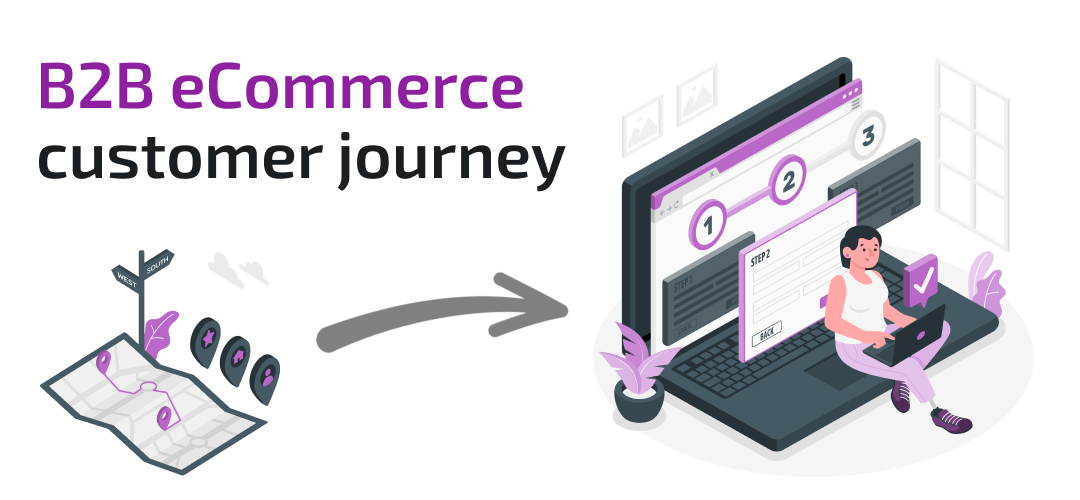
In the dynamic landscape of B2B eCommerce, mapping out all the different user personas and purchasing processes can be quite challenging. However, it's crucial to understand your customers' experience in order to boost conversions and keep them coming back.
According to Forrester Research, B2B eCommerce is projected to reach $3 trillion by 2027, highlighting the immense potential for businesses that can effectively meet their customers' needs with the help of a comprehensive B2B eCommerce customer journey.
Investing in your B2B customer journey is valuable because it has the potential to drive growth by establishing a strong customer base that consistently repurchases, renews, and advocates for your brand.
To learn more about how to create exceptional customer experiences, we invite you to read our guide on customer journey management and improvement.
What is a B2B eCommerce customer journey (and why is it so important)?
A customer journey map is a visual scheme that outlines the various steps a customer goes through when interacting with your business. It serves as a valuable tool for monitoring the customer’s perspective during the purchasing process, identifying areas of dissatisfaction, and offering more value.
The customer journey has immense significance for B2B companies, given the difficulties associated with multiple stakeholders, high-value transactions, and long-term relationships. Only by ensuring an exceptional customer journey, B2B players can reduce costs, enhance ROI, and streamline their sales cycle.
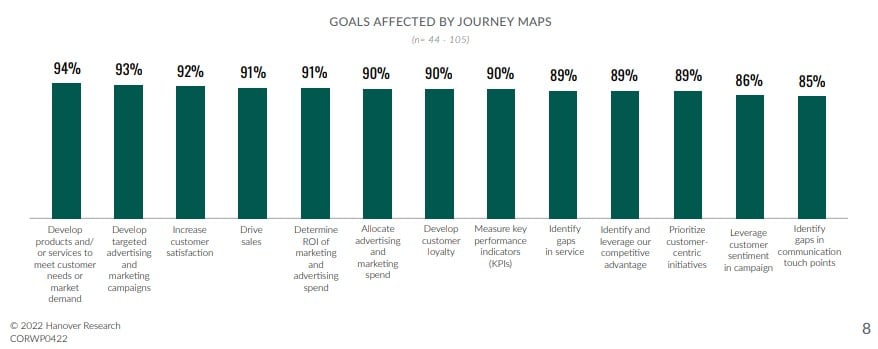
B2C vs. B2B customer journey
The B2B customer journey is undergoing a remarkable transformation and gradually adopting customer-centric strategies similar to the B2C sphere.
Gone are the days when having superior products or offering lower prices alone guaranteed success. Now, the buyer experience is a crucial factor that sets businesses apart from their competitors.
While B2C and B2B/B2B2C eCommerce share some similarities in terms of online transactions, there are notable differences between these two models to keep in mind.
- Complex decision-making. In B2C eCommerce, the decision-making process is often shorter and more straightforward. Consumers consider personal preferences, affordability, and convenience when making purchases. B2B eCommerce typically involves multiple stakeholders and longer sales cycles due to such factors as budget constraints, return on investment, and compatibility with existing systems.
- Relationship building. B2C transactions are often one-time and focus on creating positive experiences and generating repeat business. In B2B eCommerce, the relationship between the buyer and the seller tends to be more ongoing and long-term. Building trust, providing personalized support, and offering tailored solutions are essential for fostering loyalty and nurturing business partnerships.
- Personalization. B2C customers expect personalized product recommendations, targeted marketing campaigns, and shopping experiences. B2B buyers seek solutions that align with their specific business needs, i.e., product configurations, pricing, and service levels.
- Content and information. B2C customers need product descriptions, customer reviews, and pricing to make purchase decisions. B2B buyers require technical specifications, compatibility details, volume pricing, and contractual terms. Providing in-depth product documentation, case studies, and industry-specific content can enhance the B2B buying experience.
- Customer support. B2C customers may require assistance with order tracking, returns, or basic inquiries. B2B customers seek extensive support, including dedicated account management, technical support, and ongoing training.
If businesses understand these differences, they can develop and provide adequate B2B customer journey touchpoints across all the stages that buyers go through.
Basic stages of the B2B customer journey
Generally, B2B customer journey stages are not so different from interactions that shape the B2C customer journey. From initial discovery to post-purchase support, each stage of the journey presents unique opportunities to engage and satisfy customers.
Businesses can significantly enhance customer satisfaction and boost conversions by optimizing touchpoints such as search engine visibility, personalized content, intuitive navigation, and seamless checkout experiences.
The table below provides a general overview of how the B2B customer journey could look, with typical stages and marketing assets.
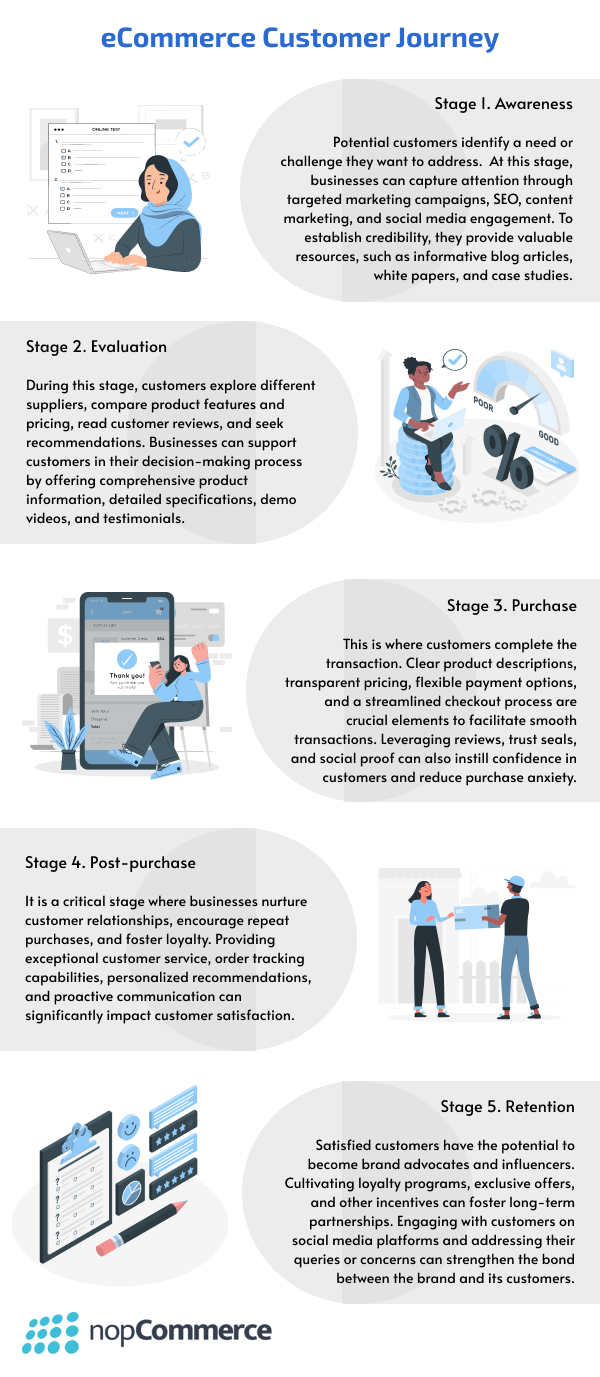
3 popular types of B2B customer journey maps
A digital customer journey in B2B can be represented by several types of maps. These visual representations help businesses gain a deeper understanding of their customers' needs, pain points, and motivations throughout the B2B buying journey.
When mapping out the customer journey, businesses can create blueprints with each touchpoint indicated. These maps cover all touchpoints, from those meant to increase interest and awareness (i.e., PR and advertising campaigns) to those related to usage (i.e. sales, account teams, support services, etc.).
Comprehensive B2B customer journey maps should include the following components:
- A flowchart or other diagram that illustrates the customer journey
- All touchpoints between a company or brand and its customers
- Areas, where the customer is likely to encounter difficulties or negative feelings, are known (i.e. “pain points”)
- The divisions and individuals providing the customer experience at each touchpoint (i.e., customer service, technical support, HR, sales, marketing, etc.)
- Connections between touchpoints
- Customer emotions elicited and desired at each touchpoint
- Importance ratings for each touchpoint
- The effectiveness of a business or brand at each touchpoint.
Here are some of the most popular types of B2B customer journey maps you can adopt:
Current-state journey map
Current-state journey maps depict existing experience with a product, service or process in a chronological order. They outline the touchpoints, emotions, and pain points encountered along the journey.
After identifying pain points, bottlenecks, and areas of improvement, current-state journey maps help uncover specific problem areas in the user experience, prioritize and address key issues.
Pros:
- Provide a comprehensive view of the user experience across various touchpoints
- Facilitate better communication and collaboration among teams and stakeholders
- Mark existing pain points and opportunities for improvement
Cons:
- Need qualitative data, interviews, and analysis, making it subjective
- Focus on the current experience and may not account for future scenarios or changing expectations.
Future-state journey map
Future-state maps are another B2B customer journey map example that envisions the ideal customer journey based on desired improvements and outcomes. Businesses can use this type of journey map to set goals, define future strategies, and outline a roadmap for enhancing the customer experience.
These maps consider emerging touchpoints and channels that may play a significant role in the future. They anticipate changes in customer behaviors, preferences, and technological advancements, providing a forward-looking perspective.
Pros:
- Consider emerging trends, technologies, and touchpoints that align with evolving customer preferences
- Provide a platform to explore new ideas, test hypotheses, and develop breakthrough experiences that differentiate the company from its competitors
Cons:
- Involve uncertainty and assumptions about future trends and customer behavior.
Day-in-the-life journey map
Day-in-the-life journey maps capture a typical day or routine, allowing organizations to deeply understand their customers' or users' behaviors, needs, and pain points throughout the day.
They provide rich insights about the environment, emotions, motivations, and challenges faced by individuals during their daily routines (unlike current-state journey maps that cover a longer period).
This level of detail helps identify pain points and opportunities for improvement at different stages of the day. The maps can be created for different user personas or segments and consider factors, such as demographics, preferences, and goals of the daily journey.
Pros:
- Provide a holistic view of the customer's life, going beyond isolated interactions
- Design solutions that fit into the user's daily routine and address their specific needs at different stages
Cons:
- There is a high degree of subjectivity
- Do not scale well for large user groups or diverse personas.
Each type of B2B marketing customer journey mapping offers unique benefits. Businesses can choose the most suitable approach based on their objectives, resources, and specific challenges and further enhance the buying process.
How to create a B2B eCommerce customer journey map in 5 steps?
Based on the information above, a comprehensive map of the buying journey can pinpoint every touchpoint where a potential customer may interact with your business. Armed with this knowledge, you can better prepare your sales, marketing, support, and other customer-facing teams to maximize sales and customer retention.
To help you get started, here’s a 5-step journey mapping process that will set you on the path to success:
1. Create your buyer personas
A buyer persona is a powerful tool in understanding and connecting with your customer segments. By creating a fictional representation of each segment, you can better understand your target audience's needs, preferences, and behaviors.
It is highly recommended to create separate buyer personas for each segment within your audience. In the process, you need to gather and analyze the following customer data:
- Goals and objectives
- Buying behaviors
- Pain points
- Demographics: age, location, gender identity, income
- Career information: job title, company, industry, decision maker, etc.
There are several ways to learn more about your audience: engage in interviews and directly communicate with customers, hold focus groups to gather valuable customer feedback or survey your customers via email.
2. Build a flowchart and identify customer touchpoints
Above we’ve already covered the five most popular customer journey stages, now they will help us create a flowchart and choose the resources and content to offer at each step of the journey.
Next, you’ll need to find out all the different points where your customers interact with your business during their buying journey. All these will be included in your B2B customer experience journey. For the most part, these stages in the table below.
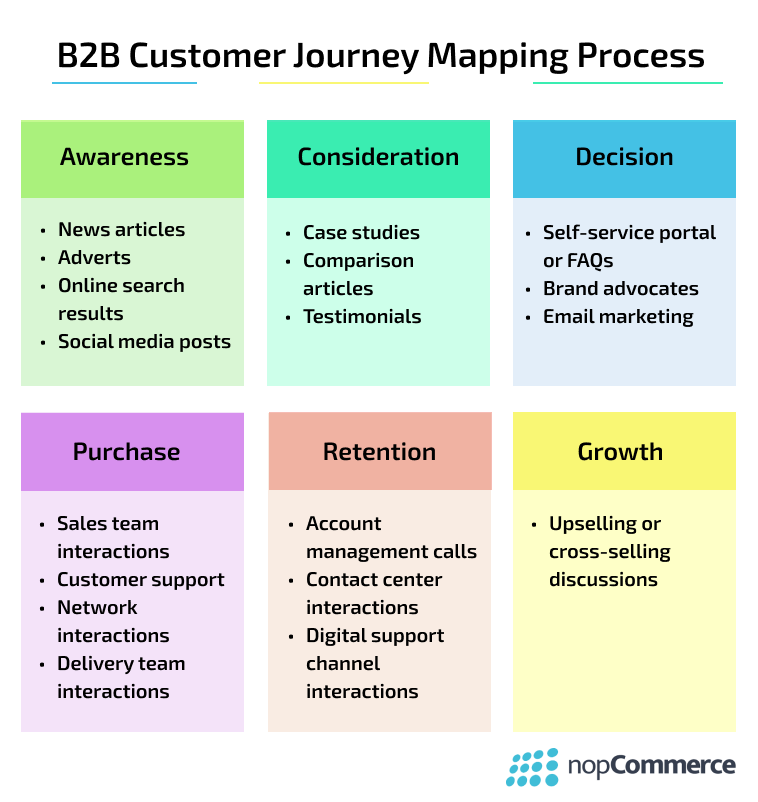
3. Reveal customer pain points
Do you notice any obstacles or pain points in the customer journey? If there are any areas where your interactions with customers are not aligned to your end goals or if you don't have someone properly monitoring a particular channel, it can cause serious disruptions.
Some of the most common issues are when you give the wrong stuff to the wrong person, use the wrong tools for the wrong type of people, and make the buying process way too complicated.
You might want to think about creating an omnichannel strategy that makes all channels work together and creates a smooth customer journey.
4. Develop an action plan
By now, you should have a good understanding of the customer journey for your business. So it's high time to build out the map and make sure all touchpoints are covered, while leaving room for making any necessary improvements.
For a start, make sure no customer is left behind. Next, find ways to enhance the customer journey. Are there any touchpoints to add? For example, think about implementing chatbots to improve customer service. Cross-selling or upselling techniques can also boost customer retention.
Take a look back at the surveys and customer research you conducted. Did customers mention any potential issues? It's important to address these problems based on the feedback you received. After that, you can focus on any other possible improvements.
5. Monitor and enhance
The final step is to continuously monitor and improve your customer journey. It's important to gather feedback from both new and existing customers to see if there are any other changes you can make to enhance their experience.
It’s also important to keep an eye on your analytics to identify any areas where customers consistently drop out of the sales funnel.
There are a few customer success metrics that you should use: Net Promoter Score (NPS), Customer satisfaction (CSAT), First contact resolution (FCR) rate, Customer retention rate, Customer lifetime value (CLV), and Conversion rate.
Just keep in mind that your customer journey map and overall strategy should be flexible, allowing you to adjust or change it based on any new data you receive from your customers.
How can you improve the B2B eCommerce customer journey?
Creating a full-fledged customer journey map once and for all isn’t the case anymore. Improving the B2B eCommerce customer journey is crucial for businesses aiming to drive customer satisfaction, increase conversions, and stay ahead of the competition.
Here are a few things you can do to achieve this goal:
Personalize the customer experience
Personalization is a powerful strategy to drive engagement and loyalty. First of all, divide your B2B customer base into segments based on industry, company size, purchasing history, or preferences. This segmentation allows to tailor marketing messages, product recommendations, and pricing to each group's specific needs.
Such content as product descriptions, marketing emails, and landing pages should resonate with the needs and interests of each B2B customer segment. Thus, highlight relevant use cases or benefits, and address pain points specific to their industry or role.
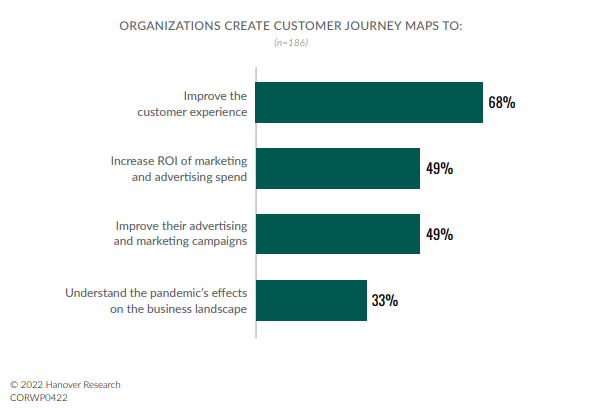
Help customers discover new offerings and increase cross-selling/upselling opportunities through smart product recommendations. Implement a pricing system and display personalized pricing to each customer.
B2B customers often negotiate custom pricing based on order volume, loyalty, or contract agreements. Consider offering dynamic discounts or volume-based pricing that adjusts automatically based on the customer's purchasing behavior.
Streamline the buying process
B2B transactions often involve multiple decision-makers, complex product configurations, and lengthy approval processes. Thus, one of the critical aspects of improving the B2B customer experience journey is simplifying the buying process.
Reduce friction and make it easier for customers to complete their purchases. Optimize your website's navigation, search functionality, and checkout process. Implement features like guest checkout, auto-fill forms, and address validation to expedite checkout. Integrate with popular payment gateways to offer a variety of payment options.
Display accurate and real-time inventory availability and pricing information to customers. This helps them make informed decisions and avoids the frustration of ordering out-of-stock items. Implement automated systems that update inventory levels and pricing in real-time.
Many B2B customers have recurring orders and will benefit from a quick reorder feature to easily replicate past orders with a few clicks. Provide a centralized account management dashboard where they can view order history, track shipments, request returns, and manage invoices.
Offer seamless customer support
Effective and seamless support ensures that customers can easily access assistance when needed, receive timely responses to inquiries, and promptly address their concerns.
Provide robust and responsive customer support throughout the entire customer journey. Offer multiple channels for support, including live chat, email, phone support, or even a dedicated support portal.
Develop a comprehensive knowledge base and FAQs section to empower customers to find answers to common queries on their own. This self-service approach saves time for both customers and support agents.
Support doesn't end with the completion of a purchase. Provide ongoing post-purchase support to address issues, offer product training or onboarding assistance, and ensure customer satisfaction.
Embrace new technology
To be ahead of your competitors, embrace emerging technologies. For instance, AI and ML can be leveraged to provide personalized product recommendations, enhance search functionalities, and automate customer support.
Implement AI-powered chatbots to provide instant and automated customer support. Automate tasks such as ticket routing, case categorization, and email responses. Workflow automation will ensure timely follow-ups and proactive notifications.
Incorporate video conferencing and screen-sharing capabilities to facilitate real-time collaboration and troubleshooting. Virtual meetings and screen-sharing sessions enable support agents to visually guide customers, resolve complex issues remotely, and provide personalized assistance.
Note: When it comes to the B2B eCommerce customer journey, the right software can make it or break it. The best B2B eCommerce platforms offer a wide range of features, such as multi-vendor support, account management, third-party integrations, etc. The chosen solution should support buyer personas and complex pricing structures, including tiered pricing, volume discounts, and negotiated pricing. Seamless integration with existing ERP, CRM, and inventory management systems will ensure real-time inventory updates, order processing, and accurate customer data.
Build an effective B2B customer journey and resolve any customer’s pain points with nopCommerce!
Creating a successful customer journey in B2B eCommerce and addressing customer pain points can be easily done with nopCommerce.
Offering a robust set of B2B features, nopCommerce emerges as a game-changer in this sphere. Whether you’re a distributor, manufacturer, or wholesaler, the software empowers businesses to create a tailored and seamless B2B customer journey responding to any needs.
For example, the platform offers user-defined roles and permissions, allowing customers to navigate their journey according to their unique internal hierarchies and buying processes. The overall purchasing experience becomes streamlined and hassle-free thanks to online checkout options and various payment gateways available.
What truly sets nopCommerce apart are its comprehensive B2B selling functionalities, designed to meet the specific needs of enterprises. From advanced pricing and negotiation tools to support for complex product catalogs, it's equipped to handle the intricacies of B2B transactions.
nopCommerce doesn't just enable businesses to build a strong customer journey but also empowers them to resolve customer pain points with minimum effort.
Closing thoughts
The B2B eCommerce customer journey can hold immense opportunities for businesses that understand and optimize its various dimensions.
Recognizing the importance of touchpoints, mapping the journey, leveraging different systems and embracing emerging technologies, companies can create exceptional experiences that drive customer loyalty, boost conversions, and help them stay ahead of the competition.